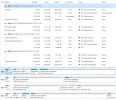- Thread Author
- #1
Would like to include Ubuntu to my setup in Windows Dual Boot Manager, but to no avail.
3 pictures included, where I have the mix of Win10 and 11 in the manager, and Ubuntu can be found
down in the options.
Pic. 01: I want Ubuntu to show up here, within the selection of Win10 or Win11.
Pic. 02: My 4 disks (two HDD's - 01 and 02) and (two SSD's - 03 and 04).
Pic. 03: Ubuntu can be found under Options in the Dual Boot Manager.
Any help ??? Thanks
3 pictures included, where I have the mix of Win10 and 11 in the manager, and Ubuntu can be found
down in the options.
Pic. 01: I want Ubuntu to show up here, within the selection of Win10 or Win11.
Pic. 02: My 4 disks (two HDD's - 01 and 02) and (two SSD's - 03 and 04).
Pic. 03: Ubuntu can be found under Options in the Dual Boot Manager.
Any help ??? Thanks


